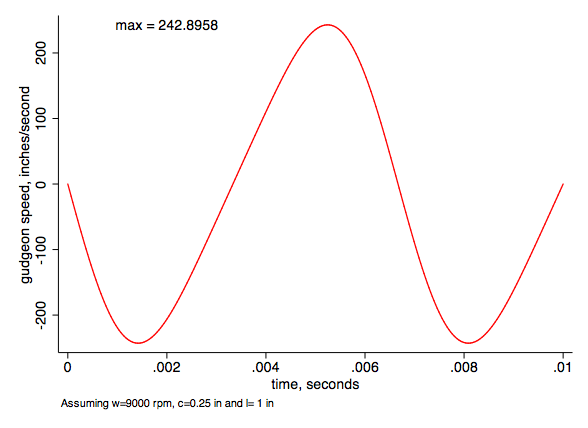- Joined
- Jan 19, 2010
- Messages
- 1,193
- Reaction score
- 41
I have been thinking about the forces being generated inside my little engine.
I wanted to calculate how fast the piston is moving.
So, with a highest recorded RPM of a little over 9000 I will use that.
9000rpm x .5" per stroke x 2 strokes per revolution = 9000 inches per minute.
9000 inches per minute = 8.5 miles per hour.
But.............This is an average, and it seems quite slow.
The piston actually comes to a complete stop at the top and bottom of every stroke, and then accelerates and de-accelerates. So how do I determine the actual TOP speed of the piston?
If I figure the speed of the center of the crank throw journal I come up with 13.4 miles per hour. Does this mean the pistons top speed cannot exceed this? Or do I need to add 1/2 the crank journal diameter to the crank circle, meaning .5" stroke plus .09375" (1/2 rod journal) = .59375" spinning 9000rpm would be 15.9 mph.
Kel
I wanted to calculate how fast the piston is moving.
So, with a highest recorded RPM of a little over 9000 I will use that.
9000rpm x .5" per stroke x 2 strokes per revolution = 9000 inches per minute.
9000 inches per minute = 8.5 miles per hour.
But.............This is an average, and it seems quite slow.
The piston actually comes to a complete stop at the top and bottom of every stroke, and then accelerates and de-accelerates. So how do I determine the actual TOP speed of the piston?
If I figure the speed of the center of the crank throw journal I come up with 13.4 miles per hour. Does this mean the pistons top speed cannot exceed this? Or do I need to add 1/2 the crank journal diameter to the crank circle, meaning .5" stroke plus .09375" (1/2 rod journal) = .59375" spinning 9000rpm would be 15.9 mph.
Kel





































































